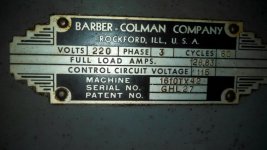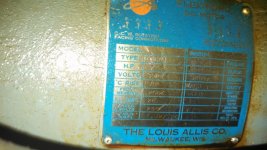Jim Fitz-Gerald
Aluminum
- Joined
- Dec 10, 2010
- Location
- Schuyler, VA USA
Hi All,
I have posted in the general section, but likely should have started here for direct advice.
I have a Barber Coleman 1610Tx42 lathe, 1961. It has an old drive with thyratrons in it. It is quite a piece. I was told the drive was bad, the motor is good. I have no proof of either, this is from the former owner who is trustworthy. Not sure what to do here but I would like to see what my options are. I have a couple of other smaller machines that will be using 220 3 PH so I am considering buying a RPC and a drive for the Coleman, just not sure which one or the best route. I am just completing my shop, the power will be on within 10 days: 220v single phase, 200A.
The motor specs are:
240 Volt, FL amps 28, field volts 240,
Feld amps: 1.32 / 0.26.
C Rise: 70
Frame: B286A
MFR: The Louis Allis Co. Milwaukee, Wisconsin
I have seen comments regarding the VFD but I am not sure they would be right for this machine. Galco, BICL and American Rotary are referenced quite a bit here.
This looks like a great old machine so I am hoping to get it going. Any advice would be appreciated.
Thanks,
Jim
I have posted in the general section, but likely should have started here for direct advice.
I have a Barber Coleman 1610Tx42 lathe, 1961. It has an old drive with thyratrons in it. It is quite a piece. I was told the drive was bad, the motor is good. I have no proof of either, this is from the former owner who is trustworthy. Not sure what to do here but I would like to see what my options are. I have a couple of other smaller machines that will be using 220 3 PH so I am considering buying a RPC and a drive for the Coleman, just not sure which one or the best route. I am just completing my shop, the power will be on within 10 days: 220v single phase, 200A.
The motor specs are:
240 Volt, FL amps 28, field volts 240,
Feld amps: 1.32 / 0.26.
C Rise: 70
Frame: B286A
MFR: The Louis Allis Co. Milwaukee, Wisconsin
I have seen comments regarding the VFD but I am not sure they would be right for this machine. Galco, BICL and American Rotary are referenced quite a bit here.
This looks like a great old machine so I am hoping to get it going. Any advice would be appreciated.
Thanks,
Jim









